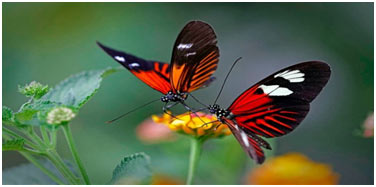The relationship between insects and humans is historic and composite. Generally, people are not insect lovers. This is mostly due to their weird, sinister, crawly, quaggy, and squirmy bodies. Also, the fact most insects infect humans but fortunately, there are also amazing and beautiful insects. These amazing insects have impressive bodies. So here the list goes of most beautiful insects.
Peacock butterfly
Scientific name: Papilio bianor
The peacock butterfly is native to Asia and found in variable sizes. The body is black with green scales like a peacock. These species are mostly found on citrus, orange, oak rue, and cork plants.

Orchid mantis
Scientific name: Hymenopus coronatus
Due to their resemblance with orchids, they are commonly known as orchid mantis. These are native to southeast Asia. They are carnivorous therefore eat small insects like flies, fruit flies, and ticks. The characteristic camouflage property protects them from potential predators.

Green lacewing fly
Scientific name: Chrysoperla carnea
Green lacewing belongs to a diverse family with almost 1200 to 1300 species. The delicate insects are characterized by their beautiful widespread wings with cross-veins. They are mostly green to greenish-brown in colour. They are widely spread all around the globe and most commonly found in Austin, Tasmania, Australia.

Little ladybug
Scientific name:Coccinella magnifica
They are also known as ladybird or lady beetles. They are found all over the world, cold and warm climates, plains and meadows. Ladybugs are yellow and orange to red in colour with black spots. Most ladybugs are predators that prey on aphids, mites, and other small insects.

Rainbow grasshopper
Scientific name:Dactylotum bicolor
They are found in desert grasslands and vegetated areas of the United States, Arizona, Texas, and Mexico. Bodies are of mainly black color with distinctive patterns and arrays of multicolours. They feed on leaves and leaf tissues of various plants.

Rosy maple moth
Scientific name: Dryocampa rubicunda
Rosy Maple moth are native mostly to Canada and the United states. Some species are also found along the Atlantic coastline and eastern Texas. Their common name shows that they live on maple trees. They have unique pink and yellow colouration. They eat leaf blades of maple.

Stick insect
Scientific name: Leptynia hispanica
They have many common names like stick insects, walking sticks, phasmids, and ghost insects. They are found in all continents except Antarctica. These are herbivores so feed on plants and found in densely vegetated areas and forests. They have stick-like bodies and range in colours from brown to grey white.

Thorn bug
Scientific name:Umbonia crassicornis
These are found in tropical regions of America, Mexico, and Florida. They are in a variety of shapes, sizes, and colors. Mostly they are greenish-brown in colour with pink to black markings. They are like thorns of plants and this property protects them from potential predators.

Golden tortoise beetle
Scientific name: Charidotella sexpunctata
It is limited to America. They have tortoise-like bodies and golden in colour but their colour change during development to nearly transparent. They consume leaves as their food.

Leaf insect
Scientific name: Phyllium philippinicum
They are the largest genus and diversity ranges from Asia, Southeast Asia to Australia. Mostly they are kept as pets. Their leaf-like appearance protect them from predators. They are herbivores and eat plant materials.

Amazing Facts about Insects
- Insects are the most diverse group of organisms on Earth.
- Around 900 thousand various species of living insects are known today.
- Insects make about 80% of the World’s species.
- The first insects were land-bound, however about 400 million years back in the Devonian era one lineage of insects evolved flight, the very first animals to do so.
- Studies show that there are almost 10 quintillion (10,000,000,000,000,000,000) individual insects alive.
- Modern insects appeared in the Jurassic era (201 to 145 million years ago).
- Insects have an open circulatory system with organs bathed in a liquid called hemolymph.

